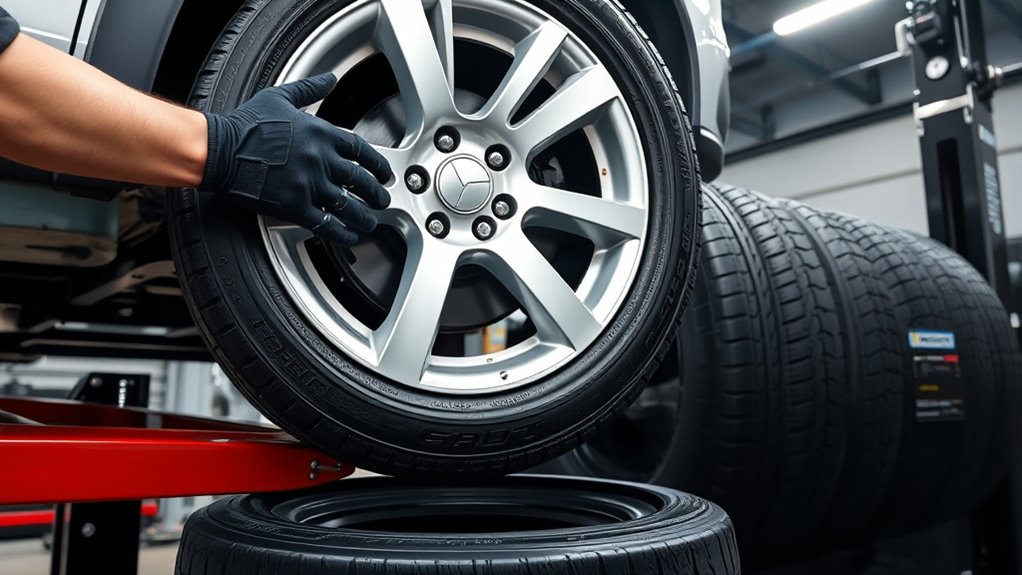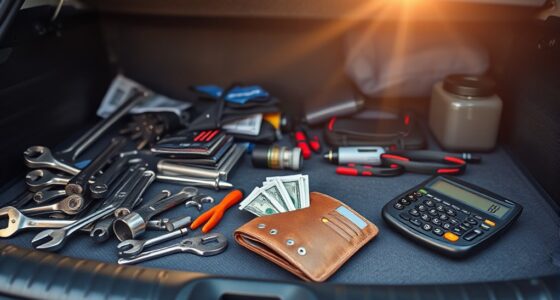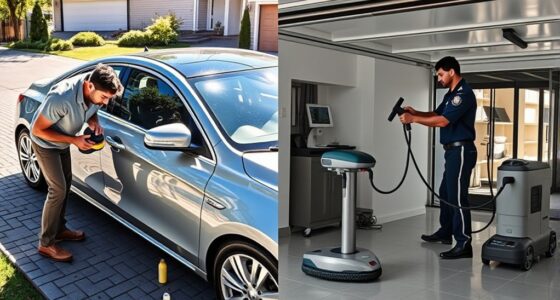To keep your tires in top shape, it’s recommended to rotate them every 5,000 to 7,500 miles, but check your owner’s manual for specific advice. Balancing costs around $15 to $25 per wheel, while rotation usually runs about $20 to $60 total. Regular maintenance prevents uneven wear, extends tire life, and keeps your vehicle safe. Stay tuned to learn more about maintaining your tires effectively and avoiding costly repairs.
Key Takeaways
- Tire rotation is typically recommended every 5,000 to 7,500 miles to ensure even wear and extend tire lifespan.
- Balancing usually costs between $15 to $50 per wheel, often included in regular tire service.
- Regular maintenance prevents uneven tire wear, reducing long-term costs and improving safety.
- Proper wheel alignment, influencing tire wear, is recommended annually or after hitting potholes or curbs.
- Combining rotation, balancing, and alignment can save money and optimize vehicle performance.

Regular tire rotation and balancing are vital steps to guarantee your vehicle’s peak performance and safety. When you don’t rotate your tires regularly, uneven tire wear patterns can develop, which may lead to reduced traction, decreased fuel efficiency, and potential tire failure. Tire wear patterns are often a sign that your tires aren’t wearing evenly, and addressing this early can save you money on replacements and prevent dangerous driving conditions. Proper tire rotation helps guarantee that all tires wear at a similar rate, extending their lifespan and maintaining maximum handling. Balancing, on the other hand, involves adjusting the weight distribution across each tire and wheel to eliminate vibrations and ensure smooth driving. If your tires aren’t balanced correctly, you might notice steering wheel vibrations, uneven tire wear, or a rough ride, all of which compromise safety and comfort.
You should check your vehicle’s owner’s manual to determine the recommended frequency for tire rotation and balancing, but a common guideline is every 5,000 to 7,500 miles. Regularly scheduling these services helps maintain even tire wear patterns and prevents issues related to misaligned wheels. Wheel alignment is another vital factor that influences tire wear and vehicle handling. If your wheels are misaligned, you’ll notice uneven tire wear, often on one side of the tire more than the other, which accelerates tire deterioration. Misalignment can be caused by hitting potholes, curbs, or general suspension wear and tear. When your wheels are properly aligned, your tires wear evenly, your vehicle handles correctly, and you improve overall safety.
Ignoring the importance of wheel alignment can lead to premature tire replacement and compromised safety. It’s advisable to have your alignment checked whenever you rotate or balance your tires, especially if you notice pulling to one side or uneven tire wear. This proactive approach helps identify alignment issues early, saving you money and maintaining your vehicle’s performance. Additionally, proper maintenance practices can help you avoid costly repairs and ensure your safety on the road. Keep in mind that balancing and rotation are relatively affordable maintenance tasks compared to replacing tires prematurely. Investing in regular rotation, balancing, and alignment not only extends your tires’ lifespan but also guarantees your vehicle handles accurately, providing a safer driving experience.
Frequently Asked Questions
How Do I Know When My Tires Need Balancing?
You’ll know your tires need balancing if you feel vibrations in the steering wheel, seat, or floorboard while driving. Check your tire pressure regularly, as low pressure can mimic balancing issues. Also, if you notice uneven tire wear or after a wheel alignment, it’s a good idea to have your tires balanced. Proper balancing guarantees smooth rides and extends tire life, so don’t ignore these signs.
Can I Rotate Tires Myself at Home?
Yes, you can rotate your tires at home with some DIY tips, but always prioritize safety precautions. Start by parking on a flat surface, engaging your parking brake, and using jack stands for stability. Remove the wheels carefully, then switch their positions according to your vehicle’s manual. Make sure to check tire pressure and tighten lug nuts properly. If you’re unsure, it’s safer to consult a professional.
What Are Signs of Uneven Tire Wear?
Uneven tire wear is like a crooked smile on your car’s face. You’ll notice bald spots, feathering edges, or cupping patterns. Keep an eye on tire pressure monitoring alerts, as uneven wear often comes from improper pressure. Regular wheel alignment checks can prevent this issue, ensuring your tires wear evenly and last longer. Addressing these signs early helps maintain smooth driving and extends your tires’ lifespan.
Does Tire Rotation Improve Fuel Efficiency?
Yes, rotating your tires can improve fuel efficiency. When you regularly rotate them, you help maintain even tire pressure and tread depth, which reduces rolling resistance. Properly inflated tires with even tread wear allow your vehicle to move more smoothly and efficiently, consuming less fuel. So, by keeping your tires rotated, you optimize performance and save money at the pump.
Are There Different Rotation Patterns for All-Wheel Drive Vehicles?
You might think all-wheel drive vehicles need special rotation patterns, but they generally follow standard ones like front-to-back or cross rotation. While some experts suggest specific patterns for AWD to guarantee even wear, most manufacturers recommend the same rotation patterns as for two-wheel drive vehicles. Regular rotation keeps your tires balanced and extends their lifespan, so check your owner’s manual for the best pattern suited to your AWD vehicle.
Conclusion
Regular tire rotation and balancing are your car’s heartbeat, keeping everything running smoothly beneath you. By staying consistent, you’re not just extending your tires’ lifespan but also steering clear of unexpected breakdowns. Think of it as tending a garden—you nurture it regularly, and it rewards you with a smooth, safe ride. So, make these simple maintenance acts your trusted compass, guiding you through life’s journey with confidence and ease.









